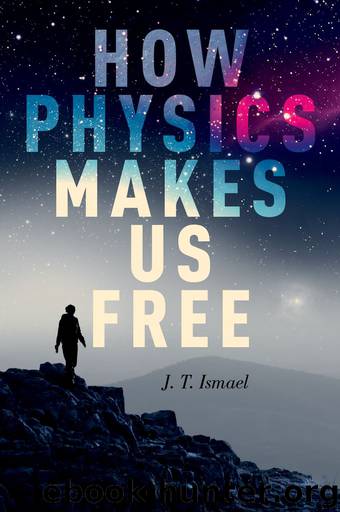How Physics Makes Us Free by J. T. Ismael

Author:J. T. Ismael
Language: eng
Format: epub
Publisher: Oxford University Press
Published: 2016-02-09T16:00:00+00:00
* * *
1 Weyl (1951), p. 6.
2 Russell (1913) and Pearl (2000).
3 Russell (1913), p. 1.
4 Russell (1913), p. 1.
5 A parameter represents a family of properties, exactly one of which pertains to the system to which the parameter is assigned at any given time.
6 Pearl (2001), p. 19.
7 http://philosophy.hku.hk/think/sci/ce-diagram.php.
8 http://www.siswebs.org/water/story.php?title=Causal_Loop_Diagram_CLD_of_Climate.
9 The acyclicity is not necessary, though a Markov constraint is customary, and we can supplement DAGs with a probability distribution to convey the strength of a connection.
10 It is always provisional, and only as good as our ability to isolate and intervene. There are, however, well-developed methods for effectively isolating systems that work well across a broad range of settings.
11 http://www.discountpoolmart.com/product_info.php?products_id=1492&osCsid=iqlmp5v20k6ge2b41fmj8i0fu1.
12 There are different ways of specifying what is to be held fixed for purposes of assessing effects of variation; directly (e.g., “hold fixed internal configuration of parts”), or indirectly (e.g., by specifying the range of applicability of a model). This will serve to identify the invariants, i.e., the class of features—internal and external—that are held fixed in assessing the results of interventions.
13 “Effective theories” here means theories that work well to capture the phenomena that fall within restricted domains, or that arise under special conditions.
14 The proper terminology is “endogenous” for variables inside the space and “exogenous” for variables whose values come from outside.
15 Pearl (2000), pp. xiii–xiv.
16 Ibid., p. xiv.
17 Hume likewise rejected the idea of compulsive relations built into the fabric of nature and argued that belief in causal power owes itself to “the mind’s great propensity to spread itself on objects” (Hume, 1740/1978, p. 167). The mind, he says, “has a productive faculty, and gilding and staining all natural objects with the colors, borrowed from internal sentiment, raises in a manner a new creation” (Hume, 1985, p. 294). He based the position on a view about how the mind works that has few contemporary adherents and gave a slightly different interpretation of the genealogy. In his view, the perception of this constant conjunction leads the mind to form a certain habit or custom: to make a “customary transition” from cause to effect. It is this felt determination of the mind, on his view, that affords us the idea of necessity. He writes, “Thus we remember to have seen that species of object we call *FLAME* and to have felt that species of sensation we call *HEAT*. We likewise call to mind their constant conjunction in all past instances. Without any farther ceremony, we call the one *CAUSE* and the other *EFFECT*, and infer the existence of the one from that of the other.” So instead of ascribing the idea of necessity to a feature of the natural world, Hume took it to arise from within the human mind, when the latter is conditioned by the observation of a regularity in nature to form an expectation of the effect.
18 Williams (1953), p. 122.
19 Russell (1913), p. 26.
Download
This site does not store any files on its server. We only index and link to content provided by other sites. Please contact the content providers to delete copyright contents if any and email us, we'll remove relevant links or contents immediately.
The remains of the day by Kazuo Ishiguro(7542)
Tools of Titans by Timothy Ferriss(6936)
The Black Swan by Nassim Nicholas Taleb(6184)
Inner Engineering: A Yogi's Guide to Joy by Sadhguru(5887)
Giovanni's Room by James Baldwin(5872)
The Way of Zen by Alan W. Watts(5790)
The Six Wives Of Henry VIII (WOMEN IN HISTORY) by Fraser Antonia(4784)
The Power of Now: A Guide to Spiritual Enlightenment by Eckhart Tolle(4749)
Astrophysics for People in a Hurry by Neil DeGrasse Tyson(4614)
Asking the Right Questions: A Guide to Critical Thinking by M. Neil Browne & Stuart M. Keeley(4566)
12 Rules for Life by Jordan B. Peterson(3724)
The Ethical Slut by Janet W. Hardy(3494)
Skin in the Game by Nassim Nicholas Taleb(3456)
Housekeeping by Marilynne Robinson(3396)
The Art of Happiness by The Dalai Lama(3378)
Double Down (Diary of a Wimpy Kid Book 11) by Jeff Kinney(3267)
Skin in the Game: Hidden Asymmetries in Daily Life by Nassim Nicholas Taleb(3259)
Walking by Henry David Thoreau(3228)
12 Rules for Life: An Antidote to Chaos by Jordan B. Peterson(3196)
